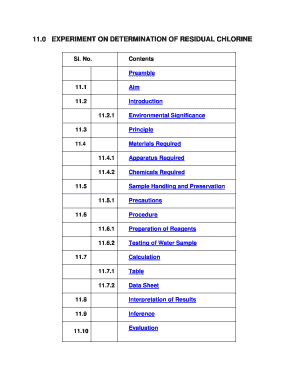Loading

Get 110 Experiment On Determination Of Residual Chlorine
How it works
-
Open form follow the instructions
-
Easily sign the form with your finger
-
Send filled & signed form or save
How to use or fill out the 110 experiment on determination of residual chlorine online
The 110 experiment on determination of residual chlorine is a critical document used to assess chlorine levels in water samples. Filling out this form accurately is essential for ensuring water quality and public health. This guide provides clear and user-friendly steps to help you complete the form online effectively.
Follow the steps to fill out the form with confidence.
- Click ‘Get Form’ button to obtain the document and open it in the online editor.
- Begin by filling in the 'Preamble' section, which sets the stage for the experiment. This includes the purpose and methodology used for determining residual chlorine.
- In the 'Aim' field, state the objective of the experiment succinctly: to determine the residual chlorine in the given water sample as per the established standards.
- Next, provide information in the 'Introduction' section, addressing the significance of measuring residual chlorine and its impact on water safety and environmental health.
- Fill out the 'Principle' section by summarizing the methodological approach, including the specific reactions involved in the measurement of chlorine.
- In the 'Materials Required' section, list the apparatus and chemicals needed for the experiment. Ensure you provide accurate descriptions and quantities.
- Complete the 'Sample Handling and Preservation' part. Include the necessary conditions for sample storage and handling to maintain sample integrity.
- Outline the 'Precautions' you should take while conducting the experiment, addressing issues like stability of chlorine and potential exposure risks.
- Proceed to the 'Procedure' section where you will detail the steps taken to conduct the experiment, specifying methods used for reagent preparation and sample testing.
- Fill out the 'Calculation' section using the data collected to summarize the results of the chlorine analysis, ensuring to reference any necessary calculations.
- Next, interpret your findings in the 'Interpretation of Results' section, giving context to the data obtained from your experiment.
- In the 'Inference' field, draw conclusions based on the residual chlorine levels and their implications for water safety.
- Complete the 'Evaluation' section by answering questions that check your understanding of the chlorination process and its consequences.
- Finally, review your inputs for any errors or omissions. Once completed, users can save changes, download, print, or share the form as needed.
Complete your document online to ensure accurate determination of residual chlorine in water samples.
A method of measuring the chlorine residual in water. The residual may be determined by either titrating or comparing a developed color with color standards. DPD stands for N,N-diethyl-p-phenylenediamine.
Industry-leading security and compliance
US Legal Forms protects your data by complying with industry-specific security standards.
-
In businnes since 199725+ years providing professional legal documents.
-
Accredited businessGuarantees that a business meets BBB accreditation standards in the US and Canada.
-
Secured by BraintreeValidated Level 1 PCI DSS compliant payment gateway that accepts most major credit and debit card brands from across the globe.


